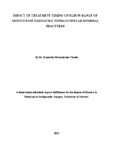| dc.contributor.author | Kasereka, Claude M | |
| dc.date.accessioned | 2013-11-12T11:57:16Z | |
| dc.date.available | 2013-11-12T11:57:16Z | |
| dc.date.issued | 2013 | |
| dc.identifier.citation | Masters in Medicine in Orthopaedic Surgery | en |
| dc.identifier.uri | http://erepository.uonbi.ac.ke:8080/xmlui/handle/123456789/58701 | |
| dc.description.abstract | Background: Supracondylar humerus fractures (SHFs) are a common pediatric elbow injury contributing 60-80% of all elbow injuries. These fractures are associated with morbidity due to elbow stiffness. Emergent management of the supracondylar fractures is thought to reduce this complication (1).
Objective: The purpose of the study was to evaluate the effect of timing of supracondylar humeral fractures treatment on the range of motion at the elbow. This aimed at improving the practice of treatment timing. It also evaluated the role of physiotherapy in treatment of residual elbow range of motion (ROM) limitation.
Design and setting: Prospective study from October 2012 to March 2013 at Kenyatta National
Hospital.
Methodology: Prospective serial study of 45 pediatric patients managed with varying waiting time to treatment, and to physiotherapy. The measurement of elbow ROM was done at 4 weeks interval, up to
12 weeks after splintage.
Patients/Participants: Forty-five children with isolated supracondylar humerus fractures were followed at 4 weeks interval assessing recovery of elbow ROM.
Results
This study found that:
The ROM (flexion-extension) improved non-linearly from 4 to 12 weeks. The incremental
change was greater in the early interval [median (IQR) 32° (24-40)] than in the latter interval [median (IQR) 12° (6-17), p<0.0001]. Similarly, the improvement in the ROM (supination- pronation plane) was greater from 4 to 8 weeks after pins and or back slab removal [median (IQR) 4° (10-20)] than from 8 to 12 weeks pins and or back slab removal [median (IQR) 32° (24-40), p<0.0001].
There was a significant inverse correlation between the time from injury to definitive management and the range of motion (in the flexion-extension axis) at 12 weeks (ρ=-0.42, p=0.005).
In the flexion-extension plane, the range of motion 12 weeks after injury was reduced in all patients relative to published normative data (28). On the other hand, supination and pronation were less severely affected, with 32/45=71% of patients having a normal ROM (supination- pronation arc) after 12 weeks.
Physiotherapy on ROM appears to be deleterious. Patients who underwent physiotherapy had a median (IQR) elbow flexion of 113° (110-128), as opposed to 129° (120-137) for those who did not undergo physiotherapy (p=0.003, MW). No significant difference was found among patients who had mild injuries after stratifying the cohort by injury severity.
Conclusion: In this study, the rate of ROM was less favorable and delay in management was remarkable. Stiffness was as a result of delay and physiotherapy negatively affected its outcome. | en |
| dc.language.iso | en | en |
| dc.publisher | University of Nairobi | en |
| dc.title | Impact of treatment timing on elbow range of motion post paediatric supracondylar humeral fractures | en |
| dc.type | Thesis | en |
| dc.description.department | a
Department of Psychiatry, University of Nairobi, ; bDepartment of Mental Health, School of Medicine,
Moi University, Eldoret, Kenya | |
| local.publisher | School of Medicine | en |

